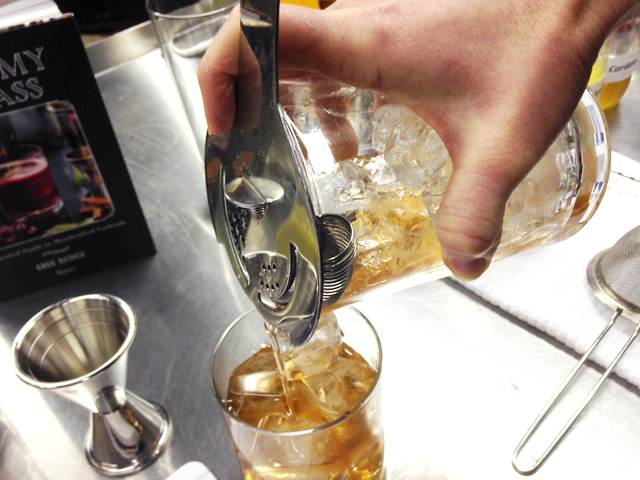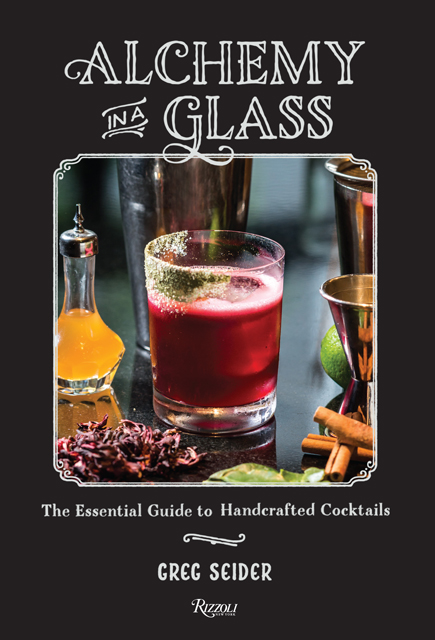Alchemy In A Glass: Simple Techniques For More Complex Cocktails
By Kristine Sherred in Food on Feb 27, 2015 7:10PM

Greg Seider shows us how to make a darn good cocktail
Cocktailing can be pretentious. Greg Seider would probably not deny that he has opinions— he did, after all, open two cocktail bars in New York City and publish a book full of his recipes called Alchemy in a Glass: The Essential Guide to Handcrafted Cocktails. Before you think, "great, another cocky barman thinking HE holds the secret to a good drink," take the prologue advice of Jim Meehan, Seider's good friend and recipe tester, and a partner at NYC's esteemed PDT: "For anyone second-guessing the author's instructions, I heartily implore you to reconsider."
Most of the time, for Seider, today's crafty libations end up falling short of how well they might read off the page. He makes a valuable point: if you can't taste the lemongrass, why use it?
His book consists of two major sections: the Seider formula classics and inspired cocktails created for his own bars Summit Bar and Manhattan Cricket Club or clients, who include NYC's famed Le Bernardin. The results of his study in flavor nuance don't dare go unnoticed. He takes plenty of classics, even oft maligned ones such as the Martini and the Cosmopolitan, and elevates them (his words) into another dimension via texture, tea and tincture.
It sounds complicated, but Seider's main technique is surprisingly simple. He picks a single flavor such as fennel and infuses it into agave, the sweetener he prefers over sugar every time for its terroir and natural extraction from the plant. The result is an otherwise typical Sazerac with unexpected herbaceousness that brings out the beauty of the drink's signature absinthe mist. These decisions are tactful, not circumstantial.
Take the Negroni: the equal parts bittersweet, sweet and spirit, for Seider, don't balance. Instead he specifically chooses Berry & Rudd's No. 3 gin, a London Dry gin more layered than the mass marketed brands, substitutes Cappelletti (a wine-based Italian bitter that is lighter and brighter than Campari) and Dolin Vermouth du Chambery Rouge. The Dolin vermouths are made from a centuries-old recipe of 30+ botanicals blended with Muscat red wine that lend layers of flavor, detectable even when mixed.

Mixing Greg Seider's balanced Negroni
The result is enlightening, Negroni fan or not. It carries everything one desires from that bittersweet concoction but without Campari's cloy competing neck-and-neck with a dry gin's pine. He opts for a 1½:¾:¾ ratio over the standard 1:1:1. In Seider's words, it becomes "crisp and crunchy." I love those adjectives to describe a liquid. "That's where the drink gets good."
Seider's specialty could be described as exotic made simple. Take a flavorful Georgia Peach Rooibos tea ("there's Rooibos and there's Rooibos," he says) and cold-steep in that soft gin for two hours, strain and then make that same Negroni. A world of thoughtful difference occurs through four simple ingredients.
"I've had a lot of dizzy days tasting every spirit in the world," jokes Seider. "The book is, you don't have to go through that— I did it for you."
His specialty concoctions showcase his wont to take an experience— a memory— and turn it into a drink.
A home bartender might be intimidated by the intense array of infused agave mixes (equal parts agave and water, for easy dilution). But start with your favorite classics, updated a la Seider, and then move to replicating his signature drinks. Bartenders, if similarly jaded by cocktail lists even at respected places, including your own, will find refreshment and perhaps a new favorite ingredient in Seider's choices.
 If there is one downfall, it might be a reliance on agave infusions and orange bitters, the latter of which he makes a case for in lieu of citrus or in an effort to extract the complexity of citrus without the sweet. Again, it is a tactful decision and one that, as a bartender, gave me pause.
If there is one downfall, it might be a reliance on agave infusions and orange bitters, the latter of which he makes a case for in lieu of citrus or in an effort to extract the complexity of citrus without the sweet. Again, it is a tactful decision and one that, as a bartender, gave me pause.
One of my first and still favorite encounters with classic cocktails starred New Orleans's underhyped Vieux Carré. Traditionally, a base of Cognac and rye meets sweet vermouth, a teaspoon of Bénédictine and aromatic bitters. Seider smartly subs another French classic for the Cognac: Calvados. American rye, the Dolin sweet vermouth again and a couple dashes of both Peychaud's and Angostura bitters sing when strained into a chilled glass with a rinse of Averna amaro. Averna in my Vieux Carré? But of course!
The third portion of the book features easy-to-follow (and you'll want to) technique, essential tools and "Seider's Chosen Ones," an index of tried-and-true spirit brands. His studied decisions force both enthusiast and professional to unearth a real reason for choosing one spirit, or flavor enhancer, over another.
Alchemy in a Glass: The Essential Guide to Handcrafted Cocktails won't be the only cocktail book you'll need, but it will become a resilient reference in an era brimming with invisible choices.